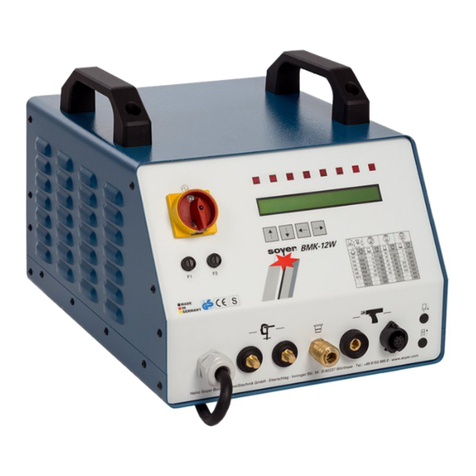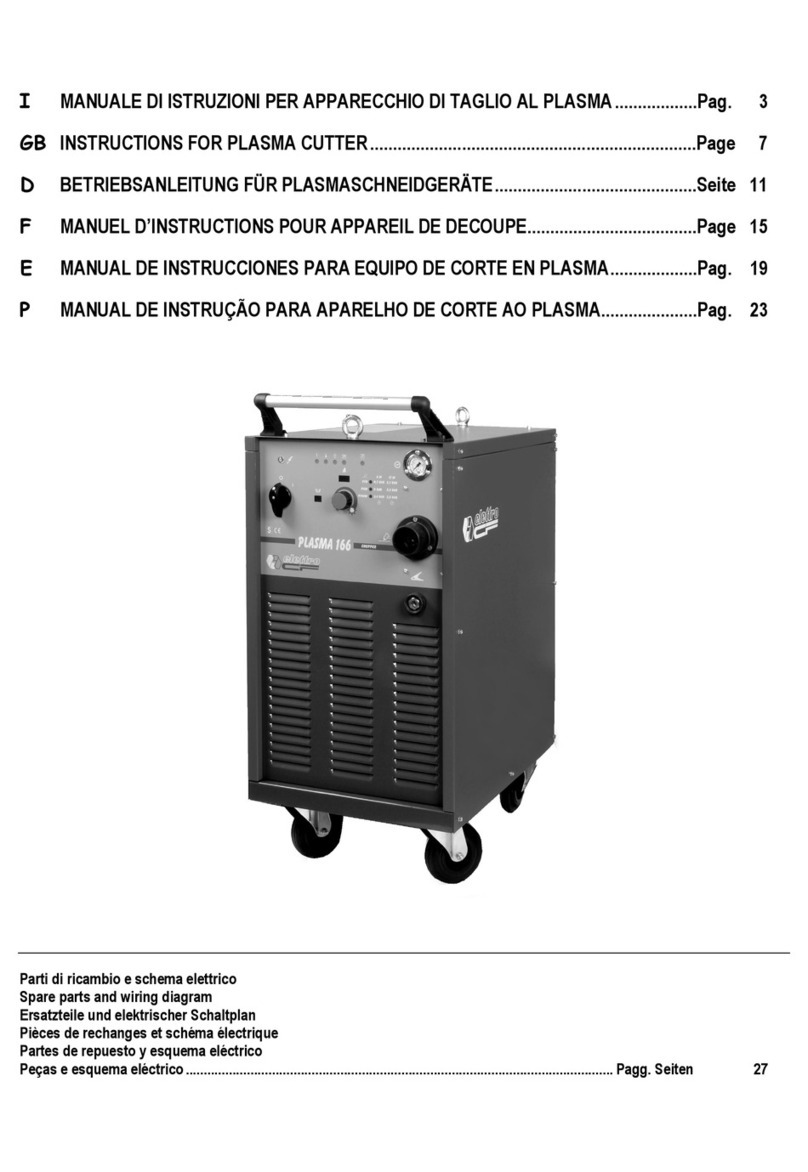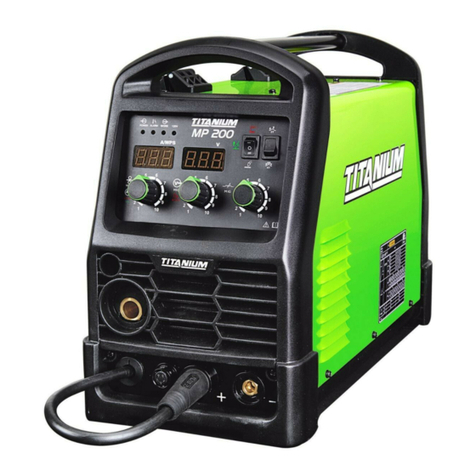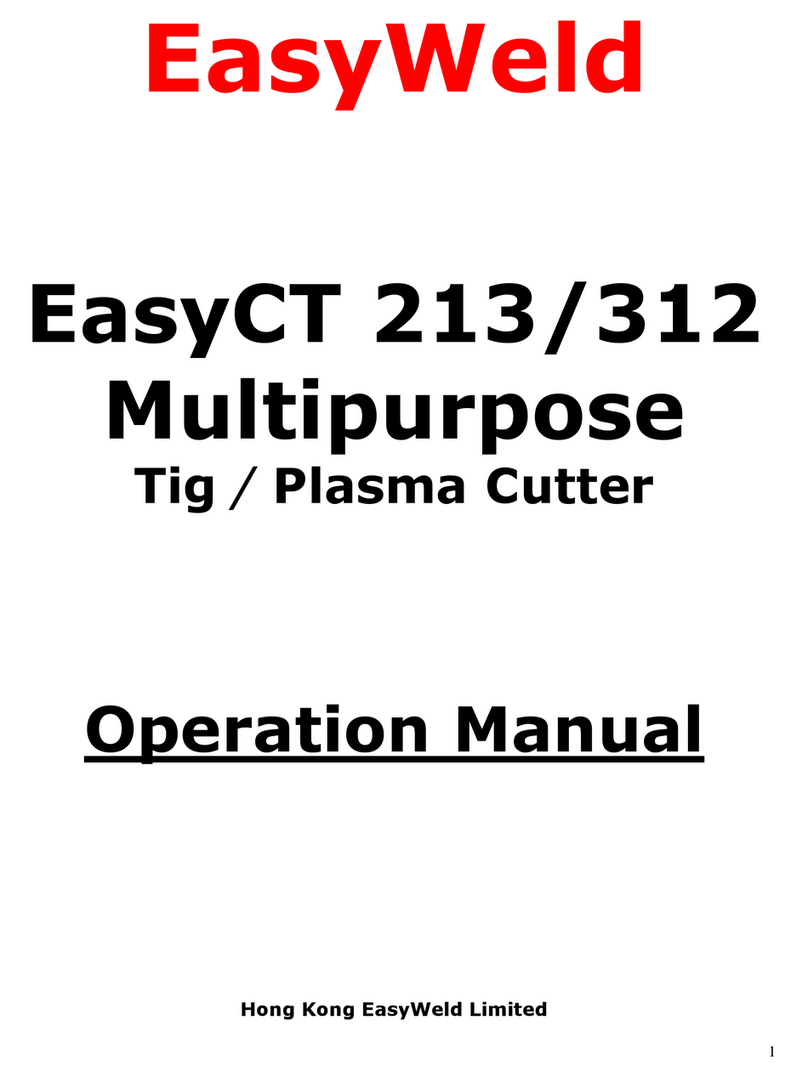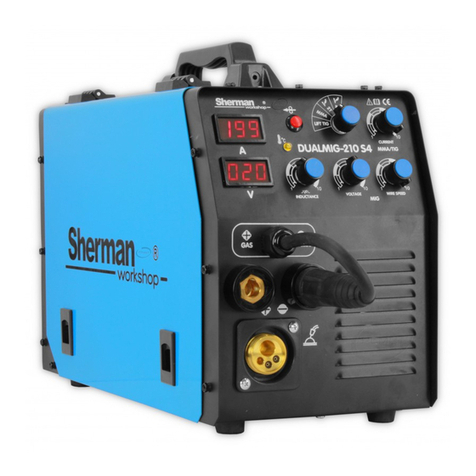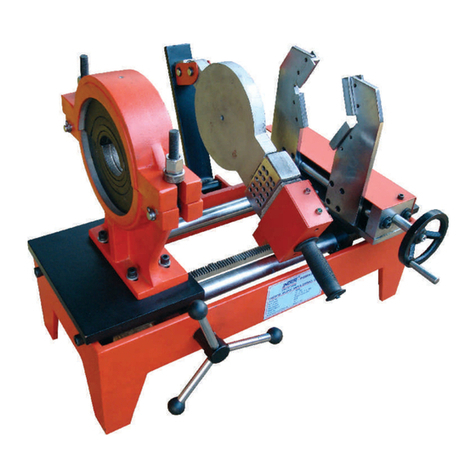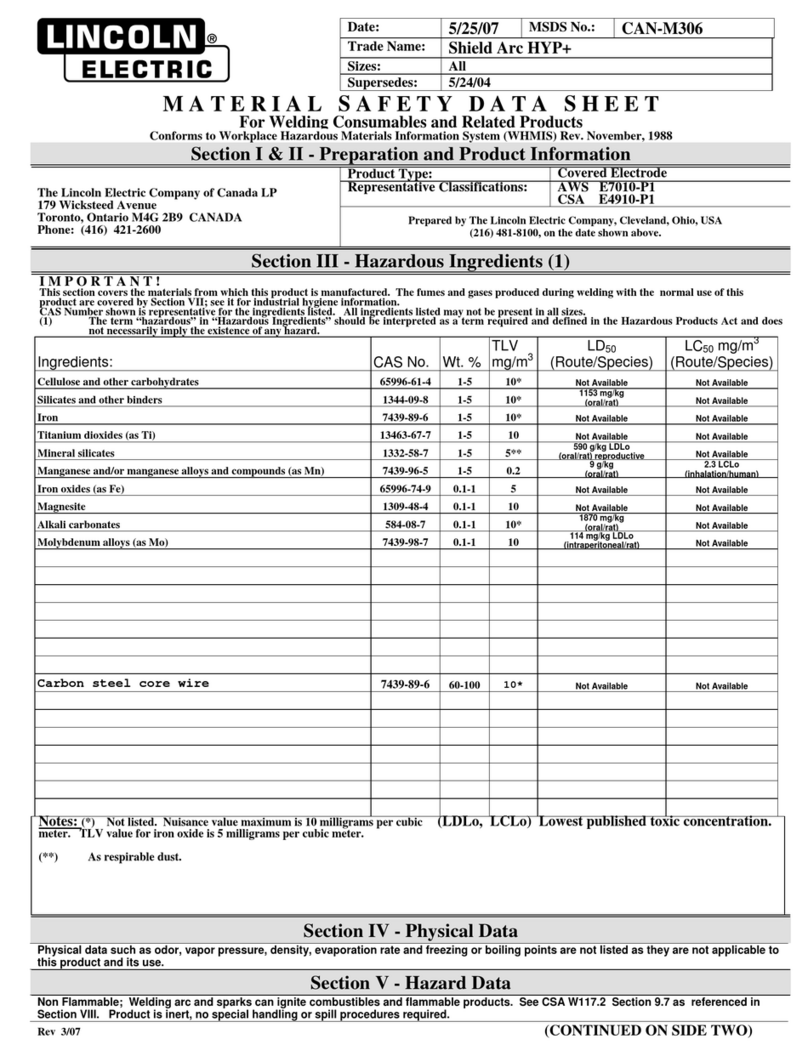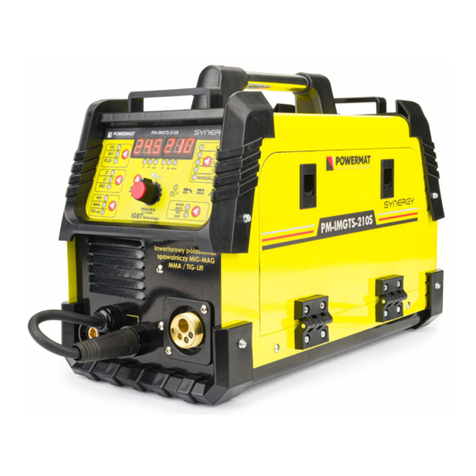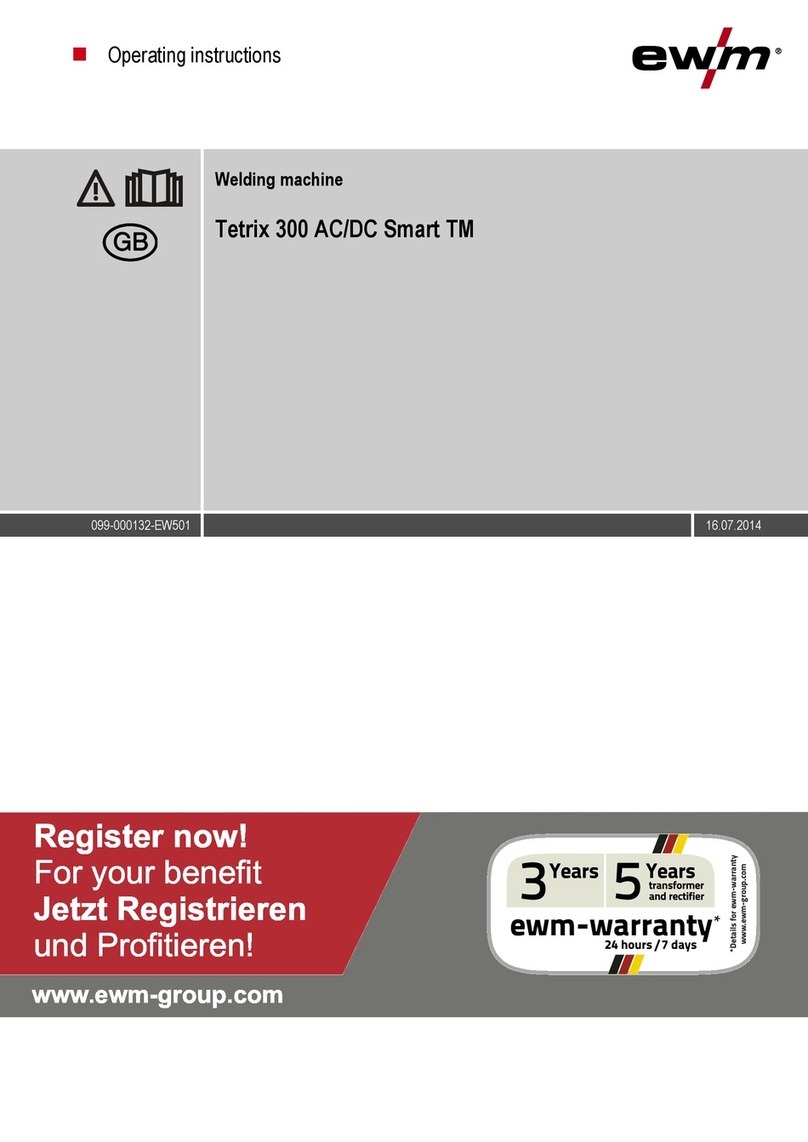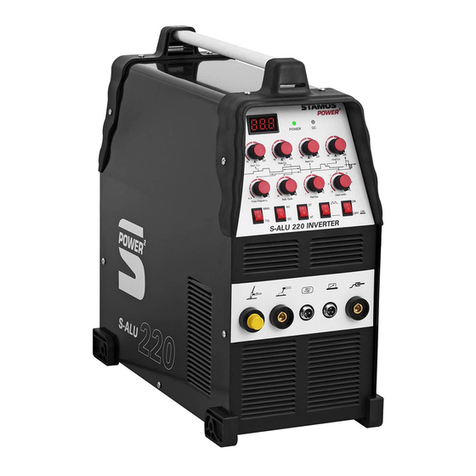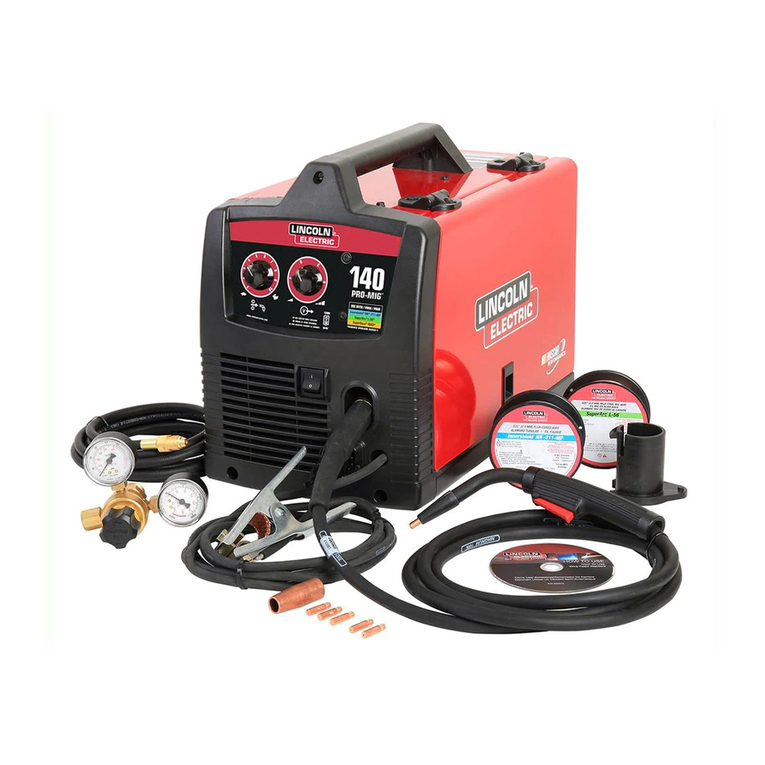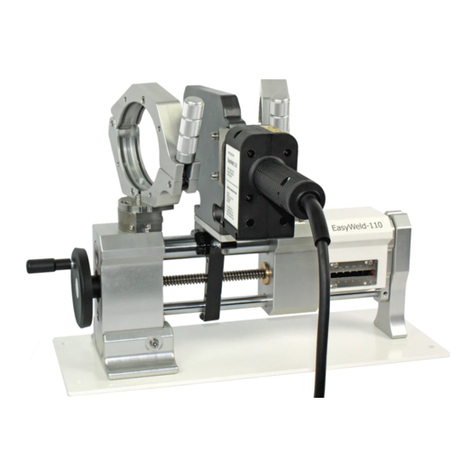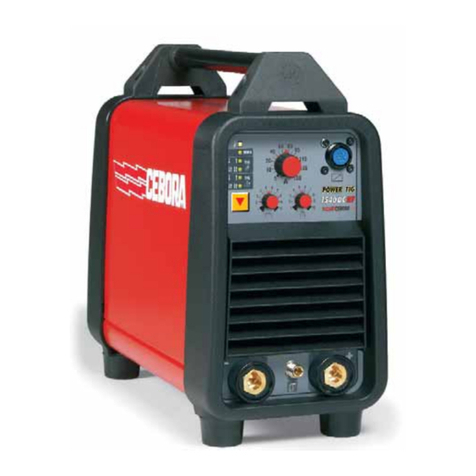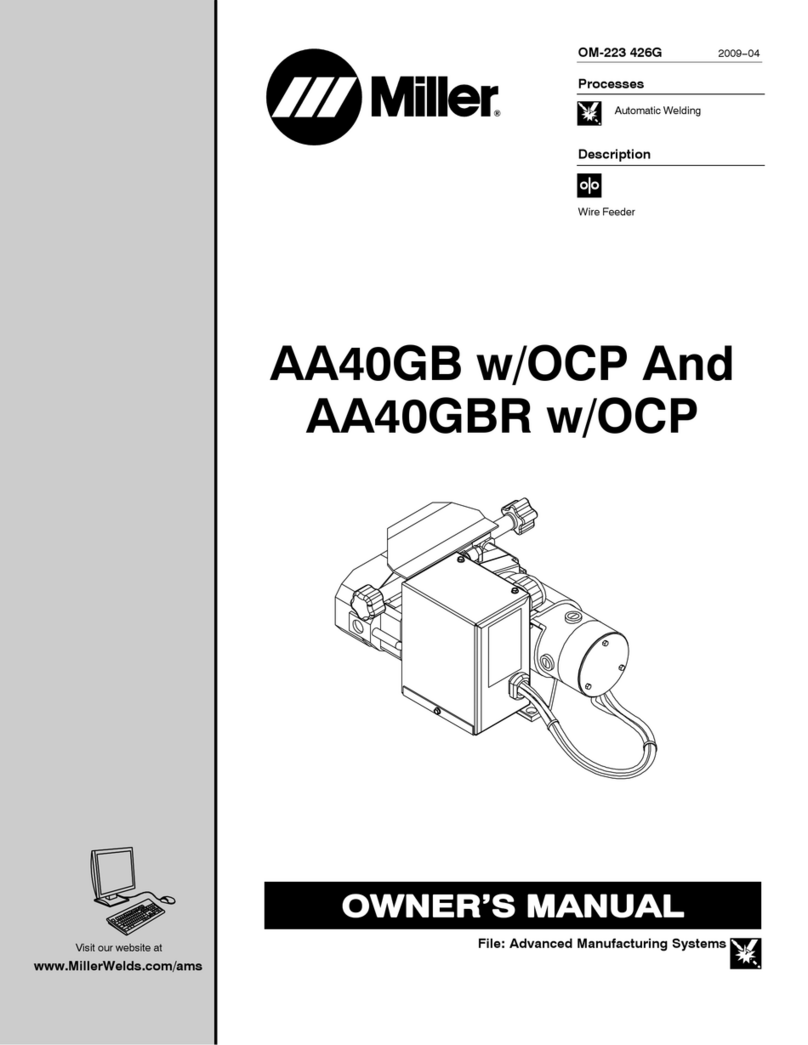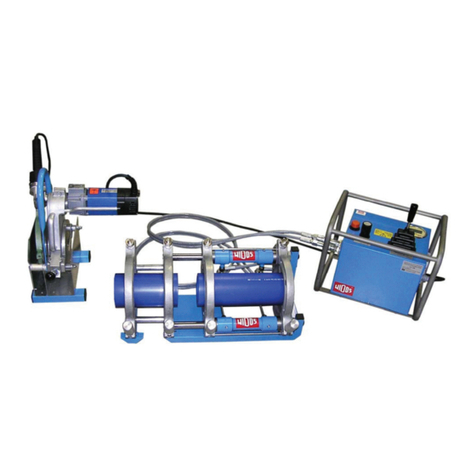Soyer BMK-12i User manual

Operating Instructions BMK-12i
Stud welding inverter for drawn arc welding
with SRM technology
GB: English Version
Read these operating instructions before starting any work!
Doc.ID: P00256
Date of issue: 10.2017
www.soyer.de

2

3
Operating Instructions
BMK-12i Stud Welding Inverter
Serial number*
BMK-12i stud welding inverter
_________________________
Please enter the serial number here, so that the data is
available if you need service support.
Order No.
Code designation
Note
P01360
BMK-12i
Mains voltage 3 x 400 V
Heinz Soyer Bolzenschweißtechnik GmbH
Inninger Straße 14 | 82237 Wörthsee | Tel.: +49 8153 8850 | Fax: +49 8153 8030 | E-mail: [email protected] | www.soyer.de

4
Thank you!
Congratulations on purchasing the BMK-12i SOYER®stud welding inverter.
You have made an excellent choice. Your BMK-12i SOYER®stud welding inverter was specially
developed for the high-speed fastening of SOYER®HZ-1 weld studs on metallic, weldable workpieces
by means of the patented SRM technology. The welding inverter also allows weld studs in
compliance with DIN EN ISO 13918 to be welded on metallic, weldable parent material.
Our devices have been tested and proven according to current European and national
guidelines on health and safety. Proof of conformity has been established and the
manufacturer is in possession of the corresponding documents.
FOR YOUR SAFETY
Read all of these operating instructions prior to start-up. Please follow all safety
precautions as well as all chapters of these operating instructions before starting
to weld. Non-compliance with the safety precautions can result in serious
personal injuries or death.
SOYER®is a registered trade mark of Heinz Soyer Bolzenschweißtechnik GmbH.
It is prohibited to distribute or reprint this document. It is also prohibited to exploit or disclose its
contents unless permission has been expressly granted. Non-compliance with this regulation will lead
to compensation for damages. All rights reserved, particularly in the case of a patent grant or a GM
registration.
We have verified that the contents of this pamphlet correspond to the hard- and software described.
Deviations, however, cannot be excluded so that we cannot warrant for absolute compliance. The
illustrations contained in this instruction manual can vary in some details from your product. This,
however, has no influence on the handling of the machine.
The data in this documentation is verified regularly and any necessary corrections incorporated in
future impressions. Any suggestions for improvement are appreciated.
Date of issue:August 10, 2017
Rev.1 (Update Declaration of Conformity)
© Heinz Soyer Bolzenschweißtechnik GmbH 2017 · All rights reserved
Printed in the Federal Republic of Germany

5
Heinz Soyer Bolzenschweißtechnik GmbH
Inninger Straße 14
82237 Wörthsee
CE Declaration of Conformity
We herewith declare that the machine described in the following and the version available on the
market correspond in design and construction to the safety and health requirements of the listed
guidelines and standards. Any unauthorised modification to this machine automatically annuls this
declaration.
Designation of machine :
Machine type :
Machine no. :
Applicable EU directives :
Applied harmonised :
standards, in particular
Applied national standards :
Date :
Stud welding device
BMK-12i
______________________
RoHS Directive (2011/65/EU)
Low Voltage Directive (2014/35/EU)
EMC Directive (2014/30/EU)
EN 60 974-1:2012
EN 60 974-10:2008
DGUV Regulation 1
03 August 2017
Producer’s signature : ____________________
Signer’s function : Managing Director

6
Table of contents
1Safety instructions................................................................................................................ 8
1.1 Description of reference signs in the operating instructions................................................ 10
1.2 Staff qualification and training.............................................................................................. 11
1.3 Dangers in the case of non-compliance with safety instructions......................................... 11
1.4 Before starting to weld... ...................................................................................................... 11
1.5 Working with the stud welding inverter ................................................................................ 11
1.6 Inadmissible operating methods .......................................................................................... 11
1.7 Stopping the welding equipment.......................................................................................... 11
2General................................................................................................................................. 12
2.1 The following should be principally observed... ................................................................... 12
2.2 Intended use ........................................................................................................................ 12
2.3 Marketing and service.......................................................................................................... 13
2.4 Information on the documentation ....................................................................................... 13
2.4.1 Information on the operating instructions ........................................................................ 13
2.4.2 Conduct in the case of malfunctions................................................................................ 13
3Description of welding equipment .................................................................................... 14
3.1Description ........................................................................................................................... 14
3.2 Stud welding in a radially symmetric magnetic field (SRM Technology) ............................. 14
3.2.1 Drawn arc stud welding technology using shielding gas................................................. 15
3.3 Technical data...................................................................................................................... 16
4Start-up................................................................................................................................. 17
4.1 Installation of equipment ...................................................................................................... 17
4.2 Front and rear view.............................................................................................................. 18
4.2.1 Operating elements ......................................................................................................... 19
4.2.2 Description of the display unit.......................................................................................... 19
4.2.3 Description of the operating modes and parameters....................................................... 20
4.2.4 Overview of menu items.................................................................................................. 22
4.2.5 Description of symbols..................................................................................................... 23
4.3 Preparation for start-up........................................................................................................ 24
4.3.1 Earth connection.............................................................................................................. 24
4.3.2 Connection of stud welding gun....................................................................................... 25
4.4 Preparation of gas supply .................................................................................................... 25
4.4.1 Gas supply....................................................................................................................... 26
4.4.2 Power supply ................................................................................................................... 27
4.5 Starting the welding equipment............................................................................................ 27
4.6 Test modes........................................................................................................................... 27
4.6.1 Operating mode "Pre-Weld Current Test" ....................................................................... 27
4.6.2Operating mode "Lift Test"............................................................................................... 28
4.6.3 Operating mode "Gas Test"............................................................................................. 29
4.7 Welding parameters............................................................................................................. 29
5Operation ............................................................................................................................. 31
5.1 Brief description ................................................................................................................... 31
5.2 Basic setting of the SRM stud chuck ................................................................................... 33
5.3 Basic setting of the SRM nut holder..................................................................................... 34

7
5.4 Start-up of the PH-9 SRM stud welding gun........................................................................ 36
5.5 Notes on the "Lifting test" operation mode........................................................................... 41
5.6 SRM welding operation........................................................................................................ 41
5.6.1 Stud welding with shielding gas....................................................................................... 42
5.7 Error messages and notes................................................................................................... 43
5.7.1 Gun connection................................................................................................................ 43
5.7.2 Increased temperature..................................................................................................... 43
5.7.3 Excessive temperature .................................................................................................... 43
5.7.4 Phase failure / overvoltage / undervoltage ...................................................................... 44
5.7.5 Error code table ............................................................................................................... 44
6Quality control (stud welding) ........................................................................................... 44
6.1 General instructions ............................................................................................................. 44
6.2 Test execution...................................................................................................................... 45
6.2.1 Production of samples..................................................................................................... 45
6.2.2 Visual inspection.............................................................................................................. 45
6.2.3 Bend test.......................................................................................................................... 46
7Maintenance......................................................................................................................... 47
7.1 Important instructions........................................................................................................... 47
7.2 Important instructions for all service works.......................................................................... 47
7.3 Cleaning............................................................................................................................... 47
7.3.1 Detergents for cleaning the housing................................................................................ 47
7.4 Replacement of components ............................................................................................... 48
8Troubleshooting.................................................................................................................. 48
8.1 Malfunctions......................................................................................................................... 49
9Transport and storage........................................................................................................ 52
10 Terms of warranty............................................................................................................... 52
11 List of standards and guidelines....................................................................................... 53

8
1 Safety instructions
These safety precautions are for your safety.
General safety instructions
Take part in a training programme. Read and follow all safety precautions listed below
and all chapters of this manual before starting to weld.
Non-compliance with the safety precautions can result in personal injuries or
death.
Only qualified persons are allowed to operate and maintain the equipment.
Children and juveniles under the age of 16 years must be kept away from the
equipment.
WARNING
It is prohibited to open the stud welding equipment.
The service personnel are required to meet special qualifications.
Our after-sales service has adequately trained personnel, suitable service equipment
and the means to carry out all necessary works.
Warning of electromagnetic fields
Keep sufficient distance from electronic devices. When stud welding, highly intensive
electromagnetic fields are created which may permanently damage these devices
(e.g. television sets, airbags).
Ensure that the welding equipment is not operated near electronically sensitive life-
support equipment, such as in intensive care units in hospitals.
Persons with pacemakers may neither operate the stud welding equipment nor stay in
the immediate vicinity while it is running.
Electric shock can cause death
Prevent electric shock by insulating your body from the working area and the ground.
Stand on dry insulating material and wear rubber soled shoes.
Inspect all cables including power cord for damage, wear or bare wiring.
Always ensure the correct supply voltage in accordance with the type plate.
Never connect the welding equipment to a power supply network with incorrect supply
voltage.
Always disconnect the welding equipment from the mains supply before starting any
cleaning works. Only trained and appropriately qualified personnel are allowed to carry
out works at the electric mains supply and welding system.
Do not touch live electrical parts with bare hand. Wear dry, hole-free insulating gloves.
Do not wear rings, watches or electrically conductive jewellery.
Keep the work area, studs, guns, cables, energy source as well as your clothes dry.

9
Fumes and gases can cause damage to your health
Fumes and suspended/floating particles may be generated during welding. Beware of
fumes detrimental to health, particularly when using surface treated materials. Please
also observe the safety regulations applicable for your country.
Do not inhale fumes and gases. Use adequate ventilation in the work area to remove
fumes and gases.
Welding can cause fire and explosions
Welding sparks and heat from flames and arcs can cause fires. Keep a portable fire
extinguisher within reach for immediate use. Be sure you are trained to use it.
When welding, do not wear clothes soiled with easily combustible substances such as
oil, grease and paraffin oil etc.
Comply with the fire regulations and do not weld, for instance, in hazardous locations.
Pay attention to flammable objects at the welding place. All flammable materials and
liquids, such as oil, fuel, etc. must be removed prior to the start of work.
Electronic equipment (e.g. airbags) and the use of explosive substances for fuel
supply require further safety precautions when carrying out welding operations on
cars. Appropriate information can be obtained from the trade associations or the car
manufacturers.
Skin and eye protection
Arc rays and welding spatters can injure eyes and skin.
Wear safety glasses with side shields and protective goggles with correct shade of
filter to protect your eyes from welding spatters and flashes of light that are generated
during the welding process.
Wear gauntlet gloves made of leather as well as non-combustible closed working
clothes such as heavy long-sleeve shirts, cuffless pants and safety shoes.
Wear a leather apron to protect your clothes from welding spatters.
Keep sleeves and collars buttoned and remove open pockets from the front side of
your clothing.
We recommend using ear protection. Some welding and working processes may
generate loud noises.

10
1.1 Description of reference signs in the operating instructions
The non-observance of safety instructions such as pictographs and warning words can cause damage
to persons. The safety instructions of this operating manual describe the following.
Safety instructions
Danger!
Warning!
Immediate hazards which could result in serious personal injuries or loss of
life.
Potential hazards which could result in serious personal injuries or loss of
life.
Caution!
Caution!
Potential hazards which could result in minor personal injuries.
Warning of damage.
Note!
Important!
Potential detrimental situation which may cause damage to the product or
to an object surrounding it.
Instructions for application and other useful information facilitating the
proper use of the product.
Safety symbols
The following pictographs for warnings, prohibitions and regulations are used in this manual:
Prohibited for persons
with pacemakers
Prohibited (only in
combination with an
additional safety symbol)
Do not touch
Housing is current-
carrying
Fire extinguisher
Warning of a danger
spot
Warning of dangerous
electric voltage
Warning of
electromagnetic field
Warning of moving
parts
General prohibition
(only in combination
with an additional
safety symbol)
Warning of inflammable
substances
Warning of explosive
substances
Eye protection
required
Protective clothing
required
Ear protection
required
Protective gloves
required
General instructions are marked with the hand symbol.

11
1.2 Staff qualification and training
The staff responsible for operation, maintenance, inspection and assembly must have the respective
qualification for carrying out these works. Field of responsibility, competence and the supervision of
staff must be carefully regulated by the user. If your personnel do not have the necessary knowledge,
they must be trained and instructed. If necessary, this can be done by the manufacturer/supplier on
behalf of the user. Furthermore, the user must ensure that the contents of the operating instructions
have been fully understood by the staff.
The society of welding institutes (GSI: Gesellschaft der Schweißtechnischen Institute mbH) offers the
appropriate training courses for your personnel.
For information on branches, please refer to website http://www.dvs-ev.de.
1.3 Dangers in the case of non-compliance with safety instructions
The non-compliance with safety instructions may not only endanger persons, but also the equipment
and its environment. Any non-compliance with safety instructions may result in a complete loss of
damage claims.
The following dangers may result if the safety instructions are not complied with:
•Failure of important system functions
•Failure of prescribed methods for maintenance
•Danger to persons through electrical, mechanical, thermal and/or acoustic influences.
1.4 Before starting to weld...
•Check the state of all cables and cable connections before starting to weld.
•Immediately replace defective cables and cable connections.
1.5 Working with the stud welding inverter
Comply with all accident prevention regulations applicable to the operation of your welding equipment.
If an accident happens,
•switch off the welding equipment and disconnect it from the mains supply and
•call a doctor
1.6 Inadmissible operating methods
Limit values
The working safety of the stud welding equipment is only guaranteed when the system is used in
accordance with its purpose. The limit values indicated in the chapter “Technical data” must never be
exceeded.
1.7 Stopping the welding equipment
•Turn off the mains switch of the stud welding equipment.
•Disconnect the mains plug from the mains socket.
•Disconnect welding gun from the welding equipment.
•Disconnect the earth cable from the welding equipment.
•Roll up the cables without buckling them.
•Prevent the welding equipment being operated by unauthorized personnel.
•Check welding cables and connections of the welding equipment for damage such as burn-off,
mechanical wear etc. and have damaged parts replaced by the SOYER®customer service.

12
2 General
2.1 The following should be principally observed...
With the BMK-12i stud welding inverter you have purchased a product which
•is state-of-the-art technology
•fully complies with the current safety requirements
•features a unique compact design
•ensures high performance.
Before installing the welding equipment, please observe the following:
•Store the operating instructions in a place accessible to every operator.
•Ensure that the respective operator has read and understood the operating instructions prior
to start-up. Each operator should confirm this per signature.
•Prevent the welding equipment being operated by unauthorized personnel.
•Only trained personnel may operate the welding equipment.
CAUTION - Hazards due to wrong gun
Hazards for the operator can arise if the wrong welding gun is used.
• Only use the welding guns from Soyer permitted in the following.
NOTE
The use of other guns or guns from another manufacturer will invalidate the declarations
of conformity and the warranties of Soyer.
Overview of permitted stud welding guns
Gun Comments
PH-9 SRM12 Standard gun
PH-9 SRM12+G Standard gun
PH-3N SRM Connection adapter required (1)
(1): Possible with optional adapter plug and adapter cable.
Adapter plug for the gas connection: F06695/FA
Adapter cable for the control cable: F06694/FA
2.2 Intended use
The BMK-12i SOYER®stud welding inverter allows you to weld pins and threaded studs from M3 –
M12 or Ø 2 - 11 mm and many other types of weld fasteners manufactured from steel, stainless steel
and aluminium.
If you need consultation or assistance in solving problems, please contact either our parent company
or our field engineers.

13
2.3 Marketing and service
If you have any questions regarding the operation, retrofits for special applications or if you require
service, please contact your responsible service office or the following address:
Heinz Soyer Bolzenschweißtechnik GmbH
Inninger Straße 14
D-82237 Wörthsee
Telephone +49 8153 8850
Telefax +49 8153 8030
www.soyer.de
info@soyer.de
2.4 Information on the documentation
The following operating instructions are supplied with the BMK-12i stud welding inverter:
• Operating instructions for BMK-12i Order No.: P00256
2.4.1 Information on the operating instructions
Legal relationship
We point out that the contents of these operating instructions are neither part of any former or existing
arrangement, pledge or legal relationship nor have they been designed to modify the latter. All
obligations of Heinz Soyer Bolzenschweißtechnik GmbH result from the respective contract of
purchase. This contract also contains the complete and universally valid warranties. These contractual
warranty terms are neither extended nor restricted by the implementation of these operating
instructions.
CAUTION
Do not carry out any actions on the stud welding equipment without specifically
knowing the operating instructions or the respective part. Ensure that only qualified
and trained personnel familiar with the operating instructions operate the system.
2.4.2 Conduct in the case of malfunctions
If malfunctions occur, first try to detect and eliminate the causes according to the list in the
"Troubleshooting" chapter of these operating instructions. In all other cases, contact our service
department.
If you require our service, please make sure that you supply us with the following information:
•Customer number
•Product designation / options
•Serial number
•Year of construction
•Material of stud and workpiece
•Stud dimensions
This information helps us save time and unnecessary costs, e.g. incurred by delivering the wrong
spare parts.

14
3 Description of welding equipment
3.1 Description
The BMK-12i stud welding inverter has been designed for mobile use. As a result of intensive
development work in the area of inverter technology, the SOYER®BMK-12i defines a completely new
equipment class. The equipment operates on the basis of a compact inverter source of electricity and
provides constant welding currents up to 800 A with extremely short welding periods. Here, the
rectified mains voltage is converted into a high-frequency voltage with a frequency of 100 kHz via an
inverter on a MOSFET basis. The electrical current is transferred via a high-frequency transformer and
is rectified on the output side. As a result of the high control rate in connection with the integrated SRM
welding procedure of the BMK-12i, the reproducibility of the weld is increased and the quality
significantly improved.
The equipment offers the possibility to store the parameters for different welding tasks as welding
programs and to call them up again at any time. In order to simplify the operation, programs for
different stud diameters can be saved. This enables a simple and rapid switching between different
welding tasks.
The equipment comprises four push-buttons as well as a full graphic display with intuitive menu
navigation on its front panel. The settings are made via the push-buttons. The operating status during
the welding process is indicated on the display.
The following stud welding procedures are supported by the equipment:
●Stud welding in a radially symmetric magnetic field (SRM)
●Drawn arc (DA) stud welding with inert gas
●Short-cycle (SC) drawn arc stud welding (without inert gas and without ceramic ring)
The PH-9 SRM stud welding gun with control cable and SRM inert gas equipment should be
connected to the BMK-12i stud welding inverter as standard gun. This operating manual exclusively
describes the BMK-12i stud welding inverter. Information regarding the stud welding guns to be used
as well as their setting can be obtained from the respective operating manuals of the stud welding
guns.
3.2 Stud welding in a radially symmetric magnetic field (SRM Technology)
For operating the BMK-12i stud welding inverter, we recommend using the patented SRM stud
welding process (patent no. 10 2004 051 389) in conjunction with the newly developed HZ-1 universal
weld stud featuring a plane end face and centring tip (patent no. 10 2006 016 553). This innovative
welding technique enables welds at a ratio of 1:10 from the sheet thickness to the stud diameter
(previously 1:4). Furthermore there is no need to use ceramic rings during this process. The numerous
advantages delivered by the SRM procedure offer completely new potential applications in the entire
field of stud welding technology (for additional information, please refer to www.hz-1.com).
Further benefits of SRM welding include:
●No disturbing weld bead
●No ceramic ferrule required even in constrained positions (out-of-position welding)
●Reduced penetration in the sheet
●Less energy consumption and shorter welding time
●No weld spatters

15
The stud comes into contact
with the workpiece and is
raised. The arc is triggered.
The arc is guided through the
spiral-shaped magnetic field
and fully melts both join parts.
The stud immerses into the
very flat penetration zone and
is inseparably connected.
The above illustration shows the radially symmetric magnetic field stud welding process (SRM).
With this welding process, we recommend using the following inert gases:
gas mixture containing 82% of Argon and 18% of CO2or gas mixture containing 90% of Argon and
10% of CO2.
3.2.1 Drawn arc stud welding technology using shielding gas
With this method, a gas mixture containing 82% of Argon and e.g. 18% of CO2(e.g. Corgon®18*) is used
as auxiliary aid. This shielding gas protects the welding point from the atmosphere and simultaneously
supports the weld pool. Moreover, it ensures a concave fillet weld upset formation with a blank metallic
surface, thus reducing the risk of corrosion and obtaining an improved dynamic behaviour of the
welded joint.
An accurate bulging, to scale or in a calibrated or reproducible type, is not possible when welding with
shielding gas without using any auxiliary aid. Stud welding with shielding gas can be carried out at
much shorter intervals as no ceramic ferrules have to be fitted and removed in each welding process.
*) Corgon®18 is a gas mixture of Linde AG in D-82049 Höllriegelskreuth
R

16
3.3 Technical data
Designation BMK-12i
Welding process Drawn arc stud welding (DS)
Welding range
SOYER®threaded studs, DIN EN ISO 13918 from
M3 – M10 RD (MR) or Ø 2 – 10 mm or M6 – M12 HZ-1
Material
Steel, stainless steel and heat-resistant steel (aluminium
conditionally depending on respective requirements)
Power source Inverter technology
Welding current 350 up to 800 A (stud welding)
Welding time 10 up to 300 ms
Welding sequence Ø 3 mm up to 12 studs/min. / Ø 10 mm up to 3 studs/min.
Standard gun PH-9 SRM stud welding gun
Power supply
CEE 32 A (3P + safety earth conductor)
3 x 400 V (+10% -15%) -50/60 Hz – 16/32 AT
E-constant current (stand-
by)
< 0.1 A / phase
E-constant power (stand-
by)
15 VA
E-peak current 60 A / phase with 3 x 400 V (short-time operation)
Open-circuit power < 30 V / DC (direct voltage)
System of protection IP 41
Shielding gas supply max. 12 l/min.
Dimensions 95 x 210 x 320 (w x h x d)
Weight with connecting
lead
7.5 kg
Colour Blue anodized
Technical specifications are subject to change without notice
WARNING
The "S" symbol is the symbol for welding current sources permitted for operation with
increased electrical danger. The "S" symbol on our stud welding devices refers
exclusively to the welding current circuit and not to the complete stud welding
equipment.

17
4 Start-up
4.1 Installation of equipment
The top of the BMK-12i stud welding inverter is equipped with a carrying handle.
CAUTION
The carrying handle is intended for transport by hand only. Never pull ropes through
this handle to lift the welding equipment by means of a crane to the installation site.
The welding equipment would become instable and might tilt from its original position.
As a result the handle could rip and the equipment would fall on the ground.
•Only install the welding equipment on an even surface. The plastic feet located on the bottom
of the equipment guarantee its anti-skid position.
•Although the welding equipment is resistant to environmental influences, it should be
protected against dampness and dust.
•Please pay particular attention to the bearing strength of the workshop furniture and ensure a
safe and stable position of the welding equipment.
•Make sure there is sufficient free space around the air apertures, otherwise the excess
temperature safety mechanism will respond and interrupt the welding process.
•Install the stud welding equipment close to the welding location.
•Ensure correct connected loads for electrical connections:
Socket CEE 32A – 6h; 3 x 400 V~ / 50 Hz / 60Hz.
The BMK-12i stud welding inverter has a four-core connecting cable: 3P + safety earth
conductor.
•Please observe that additional extension cables cause a voltage drop, possibly leading to
system disturbances.
•When welding with shielding gas, make sure the gas cylinder is installed safely in its
approved, accident-proof installation device.
NOTE
The housing of BMK-12i stud welding inverter corresponds to safety class IP 41.
Please observe that this system of protection is not suitable for being operated
or transported in the rain.

18
4.2 Front and rear view
Front view of BMK-12i
Rear view of BMK-12i

19
4.2.1 Operating elements
•ON/OFF switch
The equipment is activated by moving the rocker switch on the rear of the equipment into the
"I" position. The operating status is indicated on the activated display.
The equipment is deactivated by moving the rocker switch on the rear of the equipment into
the "O" position. The equipment is then immediately disconnected from the mains supply. The
display, however, deactivates after approx. 5 seconds.
Function keys for setting the welding parameters
The equipment comprises 4 function keys on the front panel, which are used for navigating through
the menu and setting the desired parameters. The current function of the 4 keys is shown in the
display. The functions are as follows (from left to right):
4.1 - "Navigate upwards" function key
4.2 - "Navigate downwards" function key
4.3 - "Navigate to right or parameter plus" key
4.4 - "Navigate to left or parameter minus" key
Only the functions enabled in the selected menu item are displayed.
4.2.2 Description of the display unit
The menu is divided into three pages called Main parameters, Additional parameters and System
settings. To navigate between the three menu pages, set the selection bar on the first line of Main
parameters, Additional parameters or System settings. To navigate between the three pages, use the
function keys. To change a parameter on one of the three pages, select it first by means of the
"Navigate downwards" function key. Then, using the parameter plus/minus function keys, the desired
value can be set. As soon as the lower or upper parameter threshold has been reached, the
corresponding symbol of the related function key + or - disappears and thus indicates that the
parameter threshold has been reached.

20
4.2.3 Description of the operating modes and parameters
Operating modes
Several operating modes are available which have been allocated to specific parameter lines. The
"Operation" operating mode, which is set for regular welding work, is available on the Main
Parameters page, in the Program, Main current (A) and Main current time (ms) lines. When selecting
the "Gas pre-flow time (ms)" parameter, on the other hand, the operating mode changes over to "Gas
test".
Mode Description
Operation
Mode for regular welding operation.
SRM test
Mode for testing the magnetic field without igniting an arc.
Pre-weld current
Mode for testing the pre-weld current without connecting the main current.
Lift test
Measurement of the gun fall time for the indirect measurement of the lift
height without igniting an arc.
Gas test
Gas test
In the following tables, the three pages with their respective modes for each line are indicated:
Main parameter
Menu item
Description
Area / increment
Mode
Main parameters
Page navigation with the keys 6.1 and
6.2
Stand-by
Program
Program selection (1 to 10)
1 to 10 / 1
Operation
Main current [A]
Main current value in ampere
350 to 800 / 10
Operation
Main current time [ms]
Time of the main current in
milliseconds
10 to 300 / < 50 = 1 /
> 50 = 5
Operation
SRM current [mA]
Direct current value of the SRM coil
in milliampere
0 to 1500 / 50
SRM test
Gas pre-flow time [ms]
Time of the gas flow in milliseconds
before the start of the welding
process
0 to 5000 / 500
Gas test
Drop time [ms]
Measurement of the gun drop time
for the indirect measurement of the
lift height.
Resolution in 0.25
milliseconds
Gun drop
test
Additional parameters
Menu item
Description
Mode
Additional parameters
Page navigation with the keys 6.1
and 6.2
Stand-by
Program
Program selection (1 to 10)
1 to 10 / 1
Operation
Pre-weld current time
[ms]
Pre-weld current time in
milliseconds
20 to 50 / 10
Pre-weld
current test
Pre-weld current [A]
Pre-weld current value in ampere
50 to 80 / 10
Pre-weld
current test
Gas post flow time [ms]
Time of the gas flow in milliseconds
after completion of the welding
process
0 to 5000 / 100
Gas test
Table of contents
Other Soyer Welding System manuals
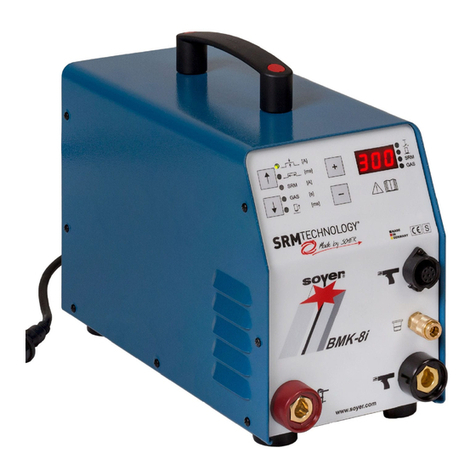
Soyer
Soyer BMK-8i User manual

Soyer
Soyer BMK-8i User manual
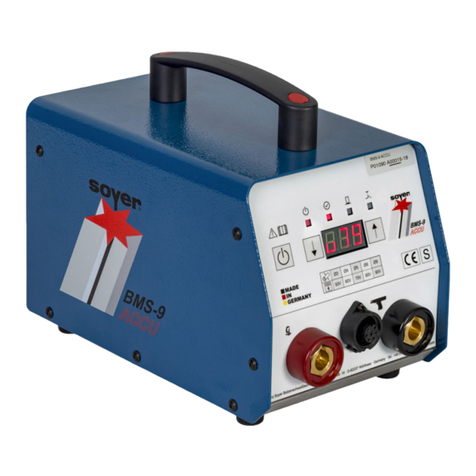
Soyer
Soyer BMS-9 ACCU User manual
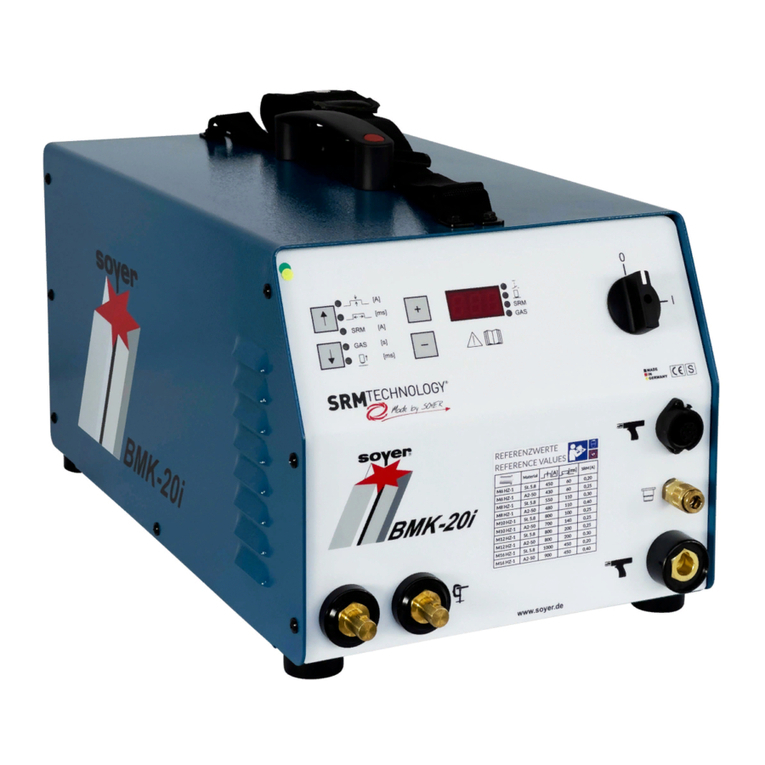
Soyer
Soyer SRM EcoWeld BMK-20i User manual
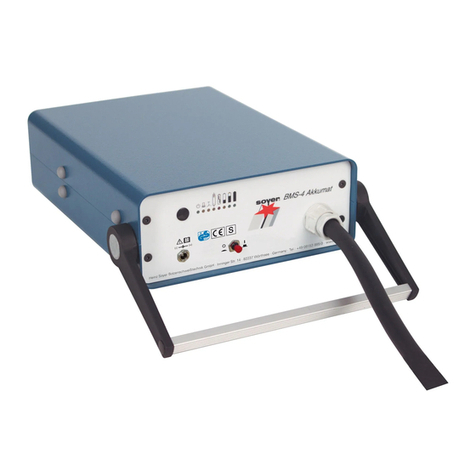
Soyer
Soyer BMS-4 Akkumat User manual
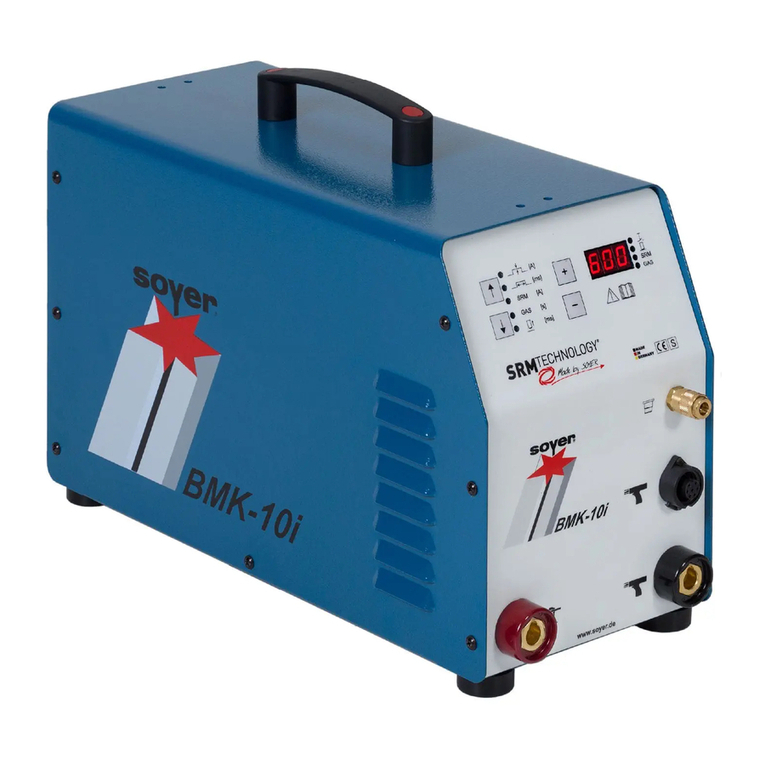
Soyer
Soyer BMK-10i User manual
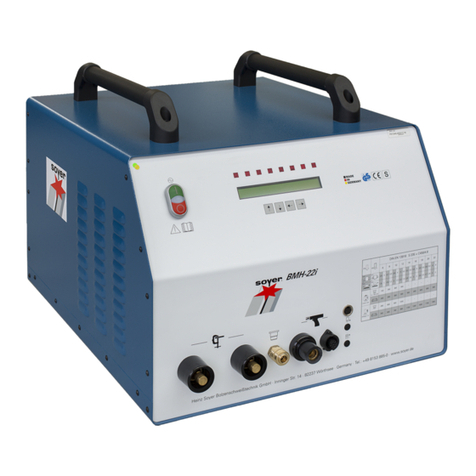
Soyer
Soyer BMH-22i User manual
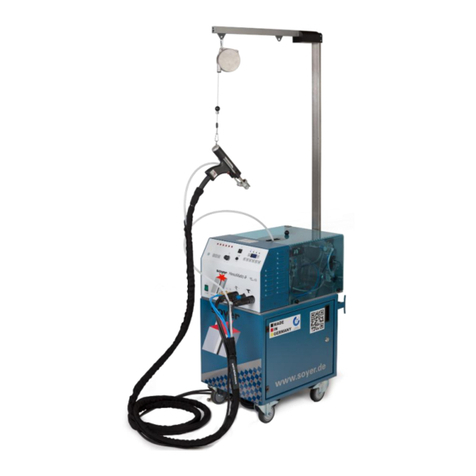
Soyer
Soyer HesoMatic-9 User manual
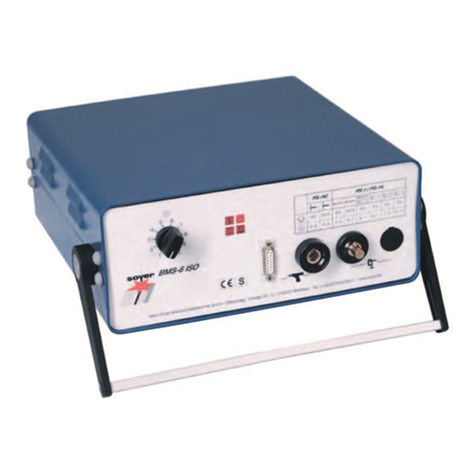
Soyer
Soyer BMS-6 User manual
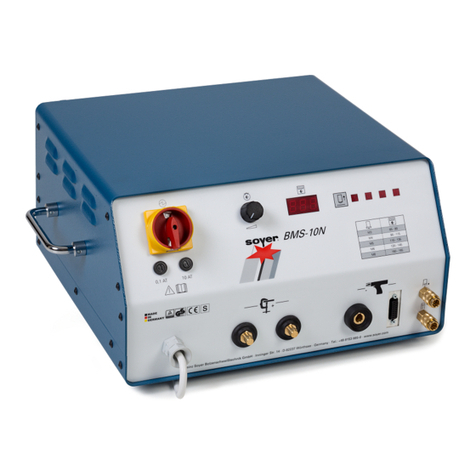
Soyer
Soyer BMS-10N User manual
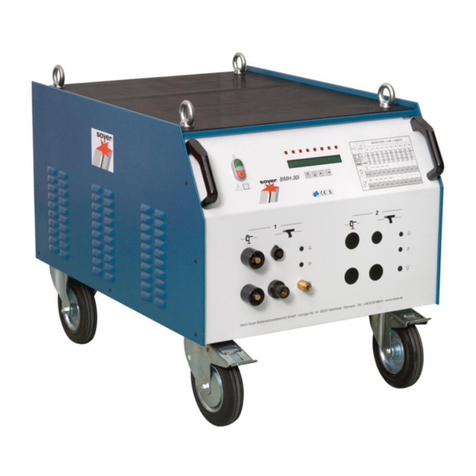
Soyer
Soyer BMH-30i User manual
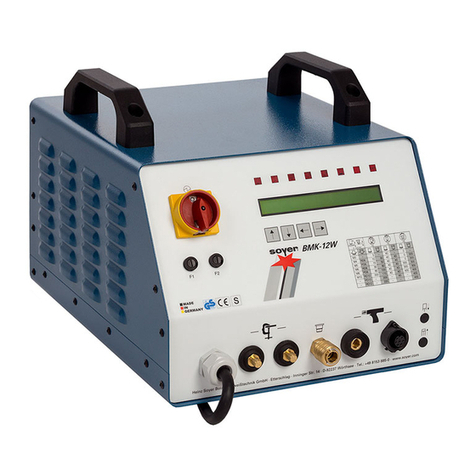
Soyer
Soyer BMK-12 W User manual
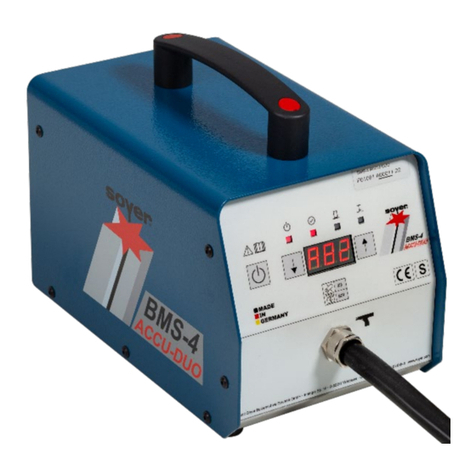
Soyer
Soyer BMS-4 ACCU-DUO User manual
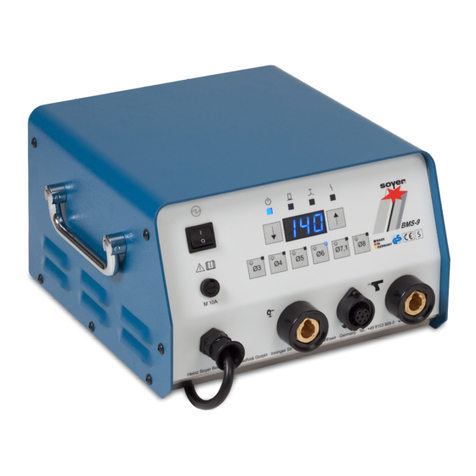
Soyer
Soyer BMS-9 ACCU User manual

Soyer
Soyer BMS-9 ACCU User manual

Soyer
Soyer BMS-9 ACCU User manual
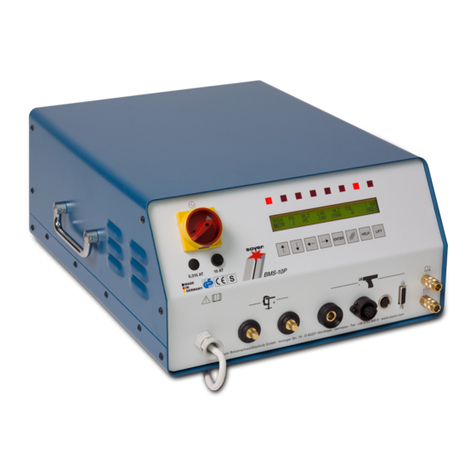
Soyer
Soyer BMS-10P User manual

Soyer
Soyer BMK-8 U User manual
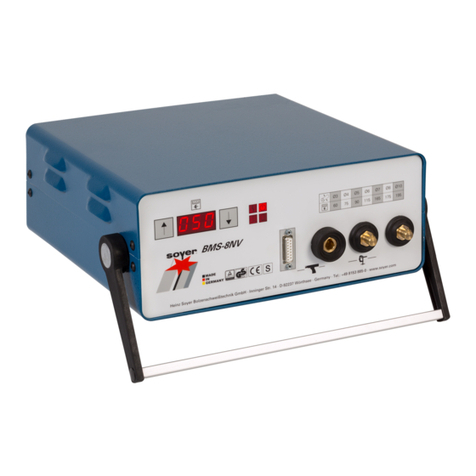
Soyer
Soyer BMS-8N User manual

Soyer
Soyer UVR-300 User manual
